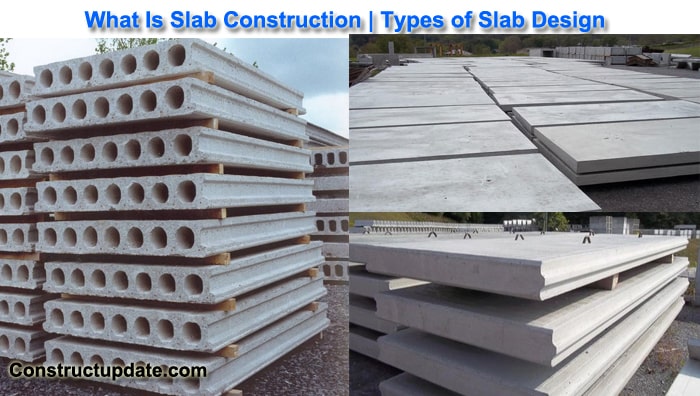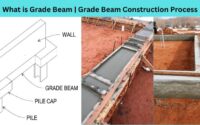What is Slab Construction | Types of Concrete Slab Design
A reinforced concrete slab is a critical structural element that provides flat surfaces in buildings (floors and ceilings). Slabs are categorised as one-way slabs or two-way slabs based on the reinforcement given beam support, and the ratio of spans. The former is supported on two sides and has a greater than two-to-one ratio of long to short span. The latter, on the other hand, is supported on four sides and has a shorter long-to-short span ratio than two.
Various circumstances and requirements need the selection of an appropriate and cost-effective concrete slab, taking into account the type of building, architectural arrangement, aesthetic elements, and span length. One-way joist slabs, flat slabs, flat plates, waffle slabs, hollow core slabs, precast slabs, slabs on grade, tough slabs, and composite slabs are all examples of concrete slabs.

Types of Concrete Slab:
- One Way Slab
- Two Way Slab
- Flat Slabs
- Conventional Slab
- Hollow Core Slab
- Hardy Slab
- Composite Slab
- Precast Slab
- Prefabricated Concrete Slabs
One Way Slab:
To carry the load in one direction, a one-way slab is supported by beams on both sides. One-way slabs have a ratio of longer spans (l) to shorter spans (b) that is equal to or greater than 2. The slab will bend in one way in this case, namely in the direction of its shorter span. However, distribution steel is used as a minimum reinforcement along the longer span above the primary reinforcement to evenly distribute the load and resist temperature and shrinkage stresses.
Two-way Slabs on Beams:
The construction of this type of slab is similar to that of a one-way slab on beams, but because two-way slabs are supported on all sides, it may require additional formwork. Slabs on beams are suited for spans of 6 to 9 metres and live weights of 3-6 kg per square metre. The beams boost the slabs’ rigidity, resulting in a low deflection. For the beams, more formwork is required.
Flat Slabs:
Because it is supported directly by columns or caps, flat slab is also known as beam-less slab. The loads are sent straight to the columns in this case.
The purpose of this sort of slab is to produce a plain ceiling surface that allows for the best light diffusion. They’re frequent in hotels, parking lots, commercial buildings, and other sites where beam projections aren’t appropriate for height control or simply aesthetics.
Conventional Slab:
A typical slab, also known as a normal slab, is one that is supported by beams and columns. The slab thickness is minimal, but the beam depth is significant, and it is transferred to the load-bearing beams and then to the columns in these types. In comparison to the flat slab, this requires more formwork. On a standard type slab, there is no need to supply column caps.
Hollow Core Slab:
The cores or voids that run through the units gave it its name. The cores can be used as service pipes, reducing the slabs’ self-weight and increasing structural efficiency. By minimising the quantity of material utilised, cores also have the advantage of being more stable.
Hardy Slab:
It is made of tough bricks, which reduce the quantity of concrete used and, as a result, the slab’s self-weight. Hardy slabs are often thicker than normal slabs, measuring roughly 270mm.
The installation of formwork, the positioning of hardy blocks, the insertion of reinforcement in gaps between blocks, the placement of steel mesh on the blocks, and finally the pouring of concrete are all steps in the construction of a hardy slab.
It is cost-effective for spans up to 5m in length, decreases the amount of concrete used below the neutral axis, and imposes modest live loads. It’s built in places where the temperatures are really high. Dubai and China are two places where this sort of slab is used.
Composite Slab:
It’s usually made of reinforced concrete that’s been cast on top of profiled steel decking. During the construction phase, the decking serves as formwork and working space, and it also serves as external reinforcement during the slab’s service life.
The span of the slab can be up to 3m for steel decking with a thickness of 50-60mm. However, by increasing the steel decking thickness to 80mm, slabs with a span of 4.5m can be built.
Precast Slab:
- Concrete slabs provide numerous advantages, ranging from basic design to long-term structure and design.
- Precast concrete slabs are manufactured in a controlled atmosphere, which is why the concrete used in construction is of exceptional quality; as a result, cracking is uncommon.
- This sort of slab is unaffected by temperature or weather.
- Because the precast concrete slab is sufficiently strong and durable, it is more stable and stronger than a concrete slab.
- This slab is tensile and compressive strength resistant.
- The thermal resistance of this slab is excellent.
Prefabricated Concrete Slabs:
- Prefabricated concrete slabs are ready-to-use slabs that are built at a factory and brought to the job site.
- A pre-stressed or post-stressed method is used to create this slab.
- Precast slabs have an advantage over normal slabs since they are built in a more regulated setting.
- The slabs are formed by pouring concrete into a mold in a well-monitored environment.
- Precast concrete slabs can also be found in industrial and institutional structures.




